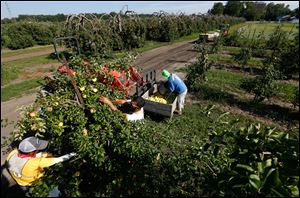
Small area farms feel effect of labor shortage
6/23/2018
Owners Fernando and Martha Mora cultivate a strawberry field at their Johnston Fruit Farms in Swanton.
The Blade/Lori King
Buy This Image
SWANTON — When he arrived in Ohio for his first summer of farm work in the United States at 16, Fernando Mora landed in a countryside bustling with migrant workers like himself.
He moved around rural Ohio with his family for several decades, digging up potatoes, harvesting tomatoes, plucking small, tasty strawberries from low bushes, and returning to Mexico come fall.
Finding work wasn’t a challenge — migrant workers have long been in demand in the heartland — but some jobs were competitive. Johnston Fruit Farms, a small family farm in Fulton County known for its flavorful strawberries, turned down Mr. Mora’s first application, passing him over in favor of more experienced pickers.

Owners Fernando and Martha Mora cultivate a strawberry field at their Johnston Fruit Farms in Swanton.
But in recent years, Ohio’s migrant work force has dwindled, with dire consequences for small to midsize growers, like Johnston. After more than 70 years’ worth of strawberries, the farm — which Mr. Mora now runs with his wife, Martha — has canceled its signature crop for lack of labor.
“Thirty years ago, there used to be migrant workers everywhere,” said Mr. Mora, who became a co-owner when he married into the family. “Now, it’s like this.”
Mr. Mora noticed a decline about 12 years ago, when regular workers began to lose touch — a grim surprise on a farm where, historically, those who come, stay. Before the drop-off, many migrants had been working at Johnston for more than 20 years.
Now, though, “they don’t show up,” Mr. Mora said, leaning on a table in a vacant sales room. By necessity, the Moras started scaling back, bit by bit. Over the past decade, they have reduced their farm’s active acreage from 30 acres to seven to fit their work force, which, during strawberry season, has shrunk from about 15 to three.
The downsize isn’t unique in a region dotted with family farms and beset by agricultural labor shortages. As the United States has sought to curb the inflow of illegal immigrant workers, farmers have increasingly turned to federal programs like the H2A guest worker visa, which allows farmers expecting shortages of U.S. labor to employ foreign workers legally without hurting American jobs.
But in Ohio, where migrant workers make up a large portion of the agricultural labor force, federal programs are not always feasible, local farmers and experts said, leaving both farmers and workers to weigh two fears: going broke and breaking the law.
“These are hard times,” Mr. Mora said. “Nobody wants to do agricultural jobs, so other people from another country, they have to come over. They should do it the legal way, yes. Is the legal way easier? No. It’s hard.”
In Ohio, labor shortage in agriculture is a decades-old issue, but the decline in migrant workers is more recent.
The number of migrant workers checking into government job help centers has more than halved since 2013, according to data from the Ohio Department of Job and Family Services.
In the department’s 2013 program year, nearly 2,000 migrant and seasonal farm workers checked into the centers, records show. In 2017, about 700 did.
Because so many foreign workers are undocumented — about 70 percent, according to Ohio’s Latin Affairs Commission — there are no official statistics on the number of migrant workers currently in Ohio. But in a 2012 study, the commission found that migrant labor was used in farming about 50,000 acres of vegetables and fruits, working crops worth $281 million. In a recent interview, Baldemar Velasquez, founder of the Farm Labor Organizing Committee, said migrant workers pump “millions and millions of dollars” into the state’s economy.
Labor concerns
As that source of labor dwindles, federal lawmakers have taken notice and have spoken out. Many have connected labor concerns with immigration as debates over border security and pathways to citizenship continue to divide the U.S. House of Representatives.

Johnston Fruit Farms co-owner Fernando Mora, center in white shirt, and his employees pick apples in the Swanton orchard.
In an interview with The Blade the day after the immigration raids in Sandusky and Castalia earlier this month, U.S. Rep. Marcy Kaptur (D., Toledo) stressed the need to curb labor trafficking, calling for renegotiation of NAFTA and a “regularized labor flow.”
In a phone conference with reporters a few weeks after the recent raids, Sen. Rob Portman (R., Ohio) said programs for migrant workers should be expanded to help alleviate the labor shortage, and that his office is monitoring the situation closely.
“We need to ensure the legal program is working better because you don’t want people to use illegal labor,” Mr. Portman said.
But the effects of the shortage are most visible down in the muck — a term for the rich soil found in northwest Ohio. Bob Filbrun, manager at Muck Crops Agricultural Research Station in Willard, Ohio, has watched local farmers struggle to keep up with their own crops for the five years he’s been on the job.
Last year, one grower told Mr. Filbrun he ran 60 workers short of his usual staff; another estimated he lost as many as 100.
In at least two counties — Sandusky and Huron — 2017 was the worst staffing year for local farms, according to a statement by Ohio State University’s College of Food, Agricultural, and Environmental Sciences.
Mr. Filbrun said fear is a major reason for the shortages. Even workers with proper documentation worry about being stopped by immigration officers, he said, which hurts employers, including those committed to hiring workers legally.
Jack Irvin, senior director of state and national affairs at the Ohio Farm Bureau Federation, took a different tack. He said the H2A program is difficult to navigate and too expensive for small to midsize growers, who can’t afford to pay the transportation, housing, and processing expenses required to participate in the program. He believes reform is needed to solve the labor shortages plaguing the country.
“We’re going to reach the tipping point,” Mr. Irvin said. “You’re going to have to import more food or more labor to meet the needs of the country.”
Weighing risks

Johnston Fruit Farms owner Martha Mora works in a strawberry patch on her Swanton farm.
Mounted on a wall inside the sales room at Johnston Fruit Farms is a portrait of the farm’s founder, Dale Johnston, who planted the farm’s first fruit trees in 1954 and committed to providing home-grown food to the local community for as long as he could stay in business.
Mrs. Mora, perched on a table a few yards from the portrait, said she’s determined to continue that tradition, even though staying both local and legal has put the farm at a disadvantage.
As the system stands, it’s easier to find regular workers if you’re big enough to benefit from H2A — which is more cost-effective for large-scale operations — or bold enough to hire undocumented workers, who will often stay in a job for fear of being reported by their employers.
Polter’s Berry Farm, a wholesale farm in Fremont that sells produce to grocery stores, is an example of how the program can work well for larger farms. There, the H2A program has staved off cutbacks and provided much-needed stability.
Owner Steve Polter said he signed up for the program four years ago because he was tired of expecting 40 workers and getting 30. The “migrant stream,” he explained, had become too unreliable.
“I think there was less and less people, less migrants competing for the same jobs,” he said.
But for small farmers who can’t afford to pay H2A’s associated expenses, unreliability has become the rule. Unlike farmers using H2A and farmers employing undocumented labor, they have no clear way of ensuring that their workers will return or even stay the summer.
Without strawberries, the Moras expect to lose money this year, though not as much as they would have if they’d invested in berries never to be picked.
“If you keep trying to do strawberries, pretty soon you can lose the whole farm,” Mr. Mora said. “You’re spending more money than you can make.”
Canceling their strawberry crop seemed like the more responsible risk.
“We got gutsy enough to do it,” Mr. Mora said. “We didn’t want to do it. But you’ve got to have workers.”
‘Blessed’
In past seasons, when the first strawberries turned red on their runners, the Moras would go out to taste them. That was the moment of truth: If the berries were small and sweet, not like the jumbo fruit sold at supermarkets, they knew their methods had worked.
“Not to brag, but Polter’s, everybody around here, they have some good strawberries,” Mr. Mora said. “But we’ve got the best strawberries.”
Despite uncertain times, Mr. Mora said he feels blessed.
“This is the best country on the planet. Everybody wants to live here, you know?”
Mr. Mora said he doesn’t blame locals for not wanting to pick strawberries or migrant workers for staying in Mexico, where he grew up, or in Florida and Texas, Ohio’s biggest supply states.
It could all be part of the cycle.
“Some people, they get caught in the middle like we do, but it’s going to get better,” Mr. Mora said. “We just got to be patient.”
In the meantime, he hopes the blueberries and apples will pay the bills.
The strawberries will have to wait for the workers.
Contact Lily Moore-Eissenberg at lillianme@theblade.com, 419-724-6368, or on Twitter @LilyM_E.